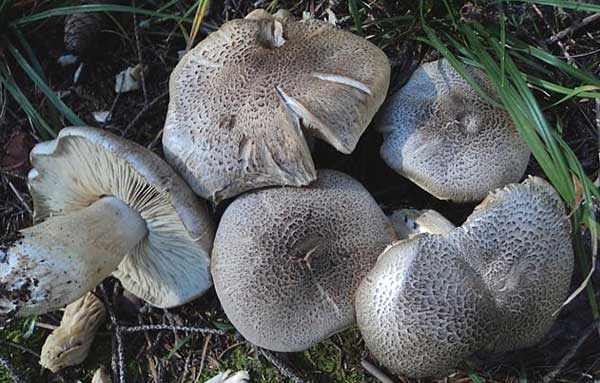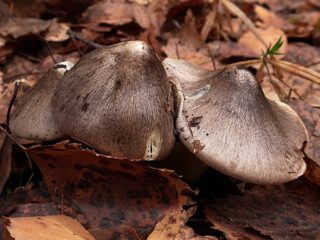Content
Fans of quiet hunting should take into account that there are deadly mushrooms. The tiger ryadovka belongs to the Ryadovkov family from the Trikholoma genus. There are other names: leopard, poisonous. The mushroom is considered poisonous, so it is not collected.
Where do tiger rows grow?
Tiger row (tricholoma pardinum) can be found in any area with a temperate climate. Mushrooms grow on calcareous soils. They can form mycorrhizae with different trees, but more often they choose conifers. Sometimes they grow one at a time, without forming large groups.
In Russia, tiger rowers are common in the central regions with a temperate climate.Small colonies called “witch rings” are often found. Mushroom glades can be found in mixed and deciduous forests, on sandy soil. Poisonous specimens choose places under pine, spruce, and oak trees.
The fruits appear in August and do not disappear until mid-October. If the weather is favorable, growth extends until November. Tiger row is found in parks, gardens, fields and meadows.
What do tiger rows look like?
Photos and descriptions of tiger row allow one to recognize this mushroom among many others. It has a pleasant taste, unlike the taste of other poisonous specimens, so not all mushroom pickers immediately recognize it.
The hat is small in size - up to 12 cm in diameter. In a young mushroom, its shape is semicircular, and then takes on the appearance of a bell. In adulthood, the cap is flat. Its color can range from gray-white to asphalt gray. The tiger rowa has scaly growths, which gives it a tiger color.
The stem of the mushroom is quite long (up to 15 cm) and dense, its diameter does not exceed 3.5 cm. Its color is white. The shape is cylindrical, with an extension at the bottom. Old mushrooms have a smooth stem, while young mushrooms have a slight fibrous stem.
The plates under the cap are thick. Their color can vary from yellowish to greenish-white. On mature plates, a discharge of watery “dew” can be seen.
The pulp of the fruit is hard and gray. After trimming, the color remains the same. The product tastes pleasant and is not bitter. And the aroma is mealy, which is inherent in rows. The spores are medium in size and ellipsoidal in shape. The mass of the powder is white.
Is it possible to eat tiger rowers?
Tiger rower is very poisonous, as it contains an unstudied toxin, which even in small quantities leads to gastrointestinal upset.
It is prohibited to eat these mushrooms.
How to distinguish tiger row mushrooms
Tiger row is easily confused with its edible counterparts from this family. During harvesting, you should carefully inspect the mushrooms. The poisonous specimen has a silver-gray cap with a bluish tint, dotted with dark scales, and a powdery coating can be seen on the stem.
The following species are similar to the tiger row:
- Earthy. This is a small mushroom, there are no yellow or green shades on the back of the cap, the flesh is not characterized by the aroma of flour. The fruits are dark gray in color, but without a blue tone. The mushroom is edible, but not everyone likes its taste.
- Gray. There are no scales on the cap. This species is edible and suitable for all types of processing. Collection season: from September to the end of November.
- Black-scaled. The mushroom has dark scales, the cap is not wrapped around the edges. Its leg is light, but turns black towards the base. The mushroom is rare, there is no data on toxicity.
- Reddish. The scales of the fruit are dark brown, and the plates have a pinkish or reddish tint. The mushroom is edible and common in Crimea.
If you have doubts about the edibility of a mushroom when going to the forest, it is advisable not to take it. It is difficult for uninformed people to determine whether a fruit is safe. You shouldn't taste it. Before cooking, you need to carefully sort through the mushrooms again. But at home, it is much more difficult to determine edibility, because mushrooms crumple in the basket and break.
Symptoms of poisoning
A person may not determine that the fruit is dangerous. The time when the first signs appear depends on the portion eaten and the general condition of the person. Symptoms usually appear within 15 minutes, but can linger for up to two hours. Digestive upset occurs even if a small amount is eaten.
When consuming brindle row, the following is likely to occur:
- severe vomiting;
- painful sensations in the stomach and intestines;
- severe diarrhea.
Dehydration occurs and a desire to drink arises. I am worried about severe abdominal pain and weakness. Sometimes a person loses consciousness. Symptoms persist for several hours. Recovery with timely measures taken lasts from 4 to 6 days.
There have been cases of liver damage. The toxin leads to severe inflammation of the mucous membranes of the stomach and intestines. If you do not consult a doctor promptly, it can be fatal. Even if poisoning is suspected, the help of a specialist is needed.
First aid for poisoning
Tiger grass poisoning is life-threatening. It’s easier not to eat mushroom dishes than to put yourself at risk. If an inedible specimen ends up on a plate and a person becomes ill after eating it, first aid must be provided.
If you are poisoned by tiger grass, you must urgently rinse your stomach with a manganese solution. You should take any sorbent available in the first aid kit (activated carbon, Ensoral, Enterosorb). If dangerous symptoms appear, you need to call an ambulance.
Gastric lavage can also be performed with saline solution. Several procedures are necessary, but it is better not to refuse medical care.
You will need to undergo examination and tests. After poisoning, medications are prescribed for detoxification.Then they begin to treat any complications that have arisen.
If the poison has led to disruption of the kidneys, heart, blood vessels, restorative treatment and adherence to a dietary diet will be required. The patient will need to eat light food for several weeks, because the gastrointestinal tract suffers the most during poisoning.
Conclusion
Tiger row is not common in forests, but you should be extremely careful when collecting. At the first signs of poisoning, gastric lavage is necessary. Treatment in a medical facility will minimize the development of dangerous consequences.













